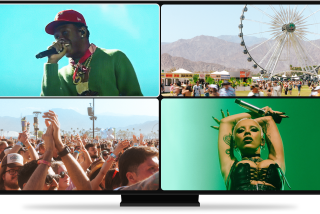Cable companies are scrambling as more viewers become cord-cutters
- Share via
Reporting from CHICAGO — The cable TV industry is setting its sights on consumers who are shunning their business.
Viewers who get their favorite shows for free by using over-the-air antennas have made “OTA” the buzzy acronym at the Internet & Television Expo being held this week in Chicago, where cable companies are gathered to mull over their fast-changing future.
There are now more than 12.3 million homes that depend solely on over-the-air broadcasting for their live TV viewing, a net gain of 1 million over the last year, according to audience measurement service Nielsen.
That’s about 11% of all U.S. households with TV — hardly a mass migration to the old-school technology.
But as the cable and satellite industries see a downward trend in the overall number of customers signing up for their video offerings while broadband Internet service continues to grow, it’s getting more attention.
Some homes are turning to over-the-air signals because they can’t afford cable.
But a growing number of them are millennials who use over-the-air TV for live sports and broadcast network shows on ABC, CBS, NBC and Fox while getting a wide array of programs from streaming video services such as Netflix, Amazon and Hulu. They are happy to pay for broadband Internet, but not TV.
At the end of 2014, Nielsen put the number of broadband homes using over-the-air signals for TV at 6.1 million — up from 5.6 million the previous year.
“Cable has got to recognize that there are broadband-only subscribers,” said cable industry veteran Tom Rogers, who now runs the video technology company TiVo. “It has to come up with some way of relating to them with [a video product].”
Bethpage, N.Y., cable operator Cablevision is making the most aggressive effort to target the emerging segment by actually offering customers broadband Internet service and a TV antenna to pull in over-the-air channels.
“Our goal is to meet the customers where they are,” Cablevision Chief Operating Officer Kristin Dolan said during an INTX panel. “We’re embracing a much more modern version of rabbit ears,” referring to the set-top antenna of the analog TV age.
Dolan said the broadband Internet service offering is aimed at “economically challenged” families, giving them basic Wi-Fi service, a Wi-Fi-only phone and an antenna to capture over-the-air signals on their TV sets for $34.95 a month.
“Price is a real issue in America today,” Dolan said.
A more expensive package is available for what Dolan calls “true cord-cutters,” the consumers who choose not to subscribe to cable and are content to get their favorite TV shows through the Internet. That service comes with a higher-speed Wi-Fi that can be used to watch HBO Now, which requires a subscription, and other streaming services. Those customers get an antenna too.
There is anecdotal evidence that over-the-air viewing is gaining steam across consumers in different economic strata as well.
Dennis Wharton, executive vice president for the National Assn. of Broadcasters, said the trade group held a TV antenna giveaway last fall at the Eastern Market in Washington, D.C. The planned three-hour event was done in just over an hour as the supply of 1,000 antennas ran out.
Many of those who showed up at the giveaway were people who disconnected their cable or satellite TV service to save money. But Wharton said they were joined in line by plenty of congressional staffers and millennials who have taken to over-the-air viewing in the way they have made vinyl records hot again in the music business.
Wharton noted that the diversity of channel offerings on over-the-air television — which has expanded since 2009 when all TV stations converted to digital signals — has made broadcast TV a more attractive low-cost alternative.
Immigrants who come to the U.S. can find a wide range of programs in various languages, especially in large markets such as Los Angeles and New York, which have dozen of channels. The percentage of broadcast-only households is higher among Latinos (16%) and Asian Americans (15%) compared with the rest of the population.
But video technology companies are likely to be courting broadband customers resistant to signing up for an expensive video channel “bundle” — which for decades enriched the cable industry and is now meeting resistance.
Rogers’ company TiVo is also planning to chase after that cord-cutting segment with a new, legal version of Aereo, the online service that enabled Internet users to watch and record local over-the-air channels on Internet-enabled devices for a monthly fee.
Aereo was shut down after the Supreme Court ruled that the service infringed broadcaster copyrights. TiVo bought the rights to the Aereo name and will keep it on the new service when it launches, Rogers said.
More to Read
From the Oscars to the Emmys.
Get the Envelope newsletter for exclusive awards season coverage, behind-the-scenes stories from the Envelope podcast and columnist Glenn Whipp’s must-read analysis.
You may occasionally receive promotional content from the Los Angeles Times.











